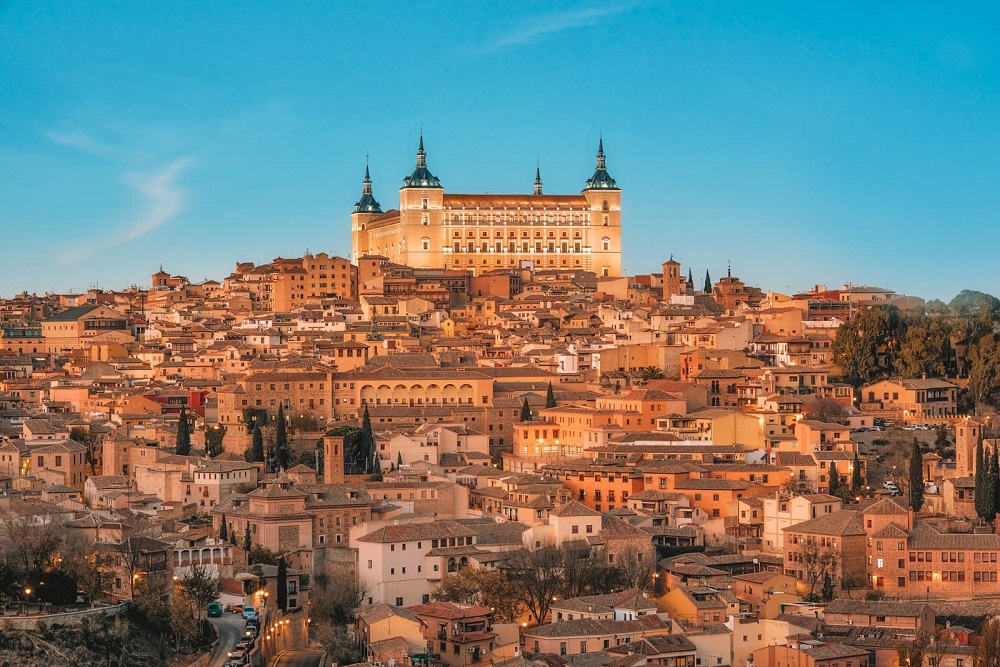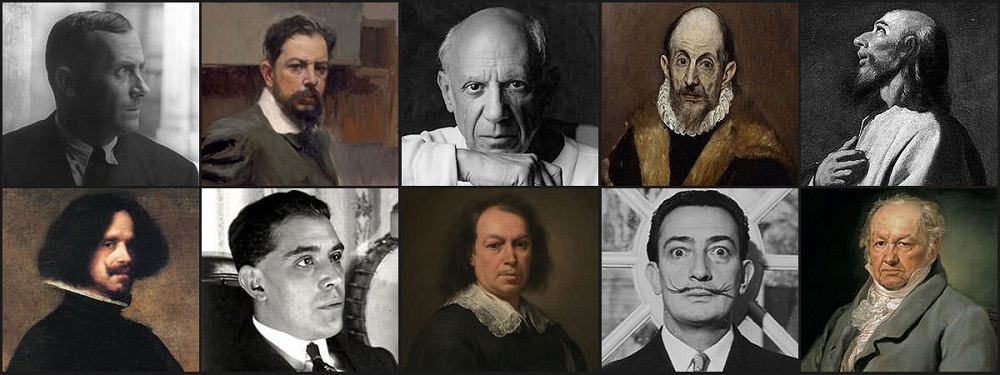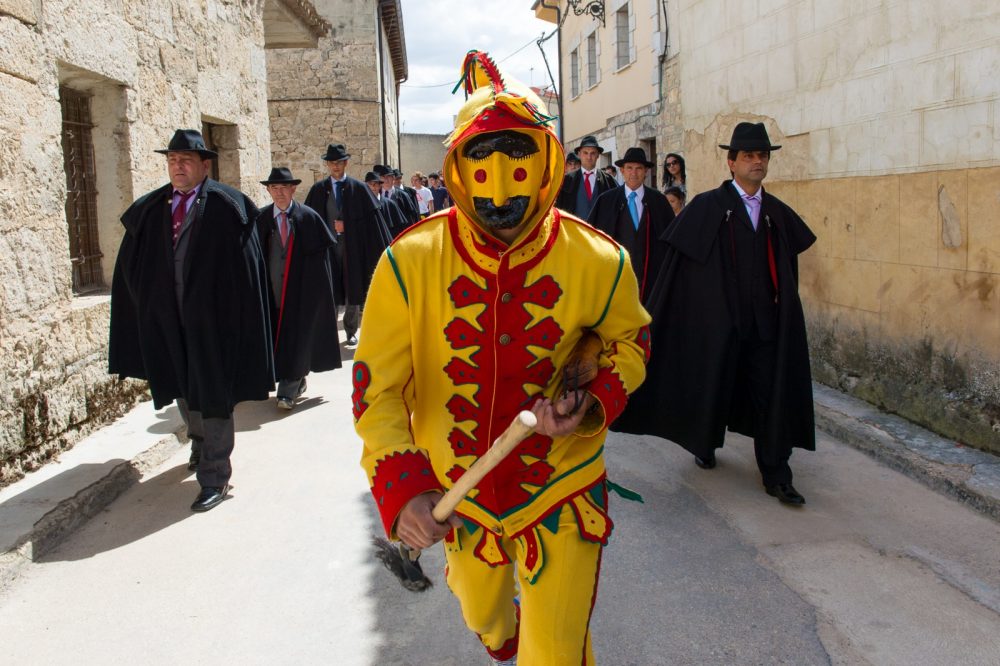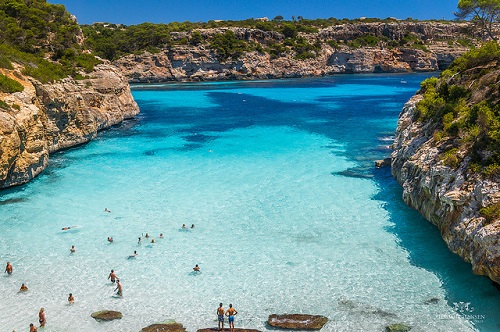Toledo is the capital of Spain, and it is an incredible cultural city. It’s witnessed many various cultures and dynasties marked on its walls, furthermore as wars, royalty, and artists. Thus discovering Toledo is certain to be distinctive expertise. Additionally, this ancient city could be a charming United Nations agency World Heritage. For hundreds of years, Christians, Jews, and Muslims thrived in a “city of three cultures” and built an astonishing array of churches, convents, palaces, fortresses, synagogues, and mosques.
1- Toledo’s Cathedral:
 via – lugaresquevisitar
via – lugaresquevisitar
Toledo’s cathedral is one among the foremost necessary Christian landmarks in Spain. The cathedral was built in the thirteenth century on the location of a Muslim mosque next to the Judería (Jewish quarter). The outside is somewhat obscured by the tightly packed buildings encompassing it, however, the inside is spectacular. The material resource of masterpieces demonstrates Toledo’s standing as a center of the Catholic Church from the 13th to15th centuries.
To go into the cathedral, worshippers should practice the Puerta Diamond State Mollete threshold. The Spanish word “Mollete” mean”muffin” which means at this door, food was given to the poor. An enormous soul-inspiring space, the interior stretches 120 meters in length with five naves. Besides, a collection of 88 richly decorated columns makes a striking impression. Besides, don’t forget to admire the sanctuary’s delicate ribbed vaulting and stunning stained-glass windows dating from the 14th, 15th, and 16th centuries.
The high altar sits in the extravagant Capilla Mayor, the masterpiece of which is the “retablo” (altarpiece), with painted wooden sculptures depicting scenes from the lives of Christ and the Virgin Mary; it’s flanked by royal tombs. The oldest of the cathedral’s splendid stained-glass pieces is that the window on the top of the Puerta del Reloj. Behind the most altar lies a captivating piece of 18th-century fancy, the Transparent, which is well-lighted by a lightweight well engraved into the dome above.
The highlight of all is that the room, which has a gallery with paintings by masters such as El Greco, Zurbarán, Caravaggio, Titian, Raphael, and Velázquez. It is tough to understand the packed-together, poorly lit artworks, however, it’s an impressive assemblage in a very tiny space. In the associate adjacent chamber, do not miss the spectacular Moorish standard captured within the Battle of Salado in 1340.
2- Monastery of San Juan de Los Reyes:
 via – spainisculture
via – spainisculture
The monastery de San Juan de Los Reyes was founded in the heart of the Jewish quarter by the Catholic monarchs Isabel and Fernando to show the supremacy of their faith.
The best part is the astonishing two-level cloister, a harmonious fusion of late “flamboyant” Gothic downstairs and Mudéjar architecture upstairs, with majestic statuary, arches, vaulting, elaborate pinnacles and gargoyles surrounding a lush garden. The adjacent church has a series of various coats of arms of the Catholic monarchs, who were never shy about self-publicizing. Outside, note the chains dangling from the northeastern facade they once belonged to Christian prisoners liberated from Muslim Granada.
3- Santa Cruz Museum:
 via – tripwolf
via – tripwolf
It’s hard to imagine that this 16th-century building was once a hospital, a charming building with an exquisite Plateresque facade. The Santa Cruz Museum contains three collections: Archaeology, Fine Arts, and Decorative Arts.
The Archeology section includes prehistoric, Roman, Visigothic antiquities, and shows of Moorish and Mudéjar decorative objects and ceramics. In the Fine Arts collection, the paintings of the 16th and 17th century School of Toledo are a major attraction, especially the masterpiece of The Assumption of the Virgin by El Greco created in the artist’s later years.
Other highlights are the Christ in Chains by Morales and the Crucifixion by Goya. The Decorative Arts section contains Flemish tapestries of the 15th and 16th centuries and a tapestry demonstrating the signs of the Zodiac as well as local artisan crafts.
4- City walls of Toledo:
 via – myworldshots
via – myworldshots
City walls were built originally by the Romans, restate by the Visigoths, expanded by the Moors, and extended again after the Christian reconquest. Toledo’s walls are surprisingly complete today, with well-conserved reminders of their mixed history. The only enduring part of the Moorish town walls is the Puerta Vieja de Bisagra, a ninth-century entrance gate. Typical of Muslim architecture, the gate features horseshoe arches, and two blind pointed arches are for decoration. This monument is also known as the Puerta Vieja de Alfonso VI because the king made his entrance to Toledo in 1085 through this gate.
5- Alcazar:
 via – cntraveler
via – cntraveler
Alcazar is a great place to discover the history and culture of Toledo, and it is worth seeing for its impressive panorama. It was built on the city’s highest point for military and strategic benefits, which means Alcazar is a fortress. It was first used as a Roman palace in the 3rd century, passing to some of Spain’s royalty before being vanquished by the Arabs, who had a very strong impact in this city.
Today, it is a museum with multiple exhibitions that center on the evolution of military strategy and weapons. Moreover, people who enjoy seeing military museums will be able to discover the following sections models, firearms, knives, uniforms, military orders, and other documents. Because nowadays Alcazar becomes an army museum.
Besides, the museum includes 13 thematic rooms with different collections, plus eight room’s exhibiting a chronological journey of Spanish military History. You’ll also find the Regional Library of Castilla la Mancha, including more than 380,000 books and containing some special volumes. As far as architecture goes, you’ll discover the main patio, which is pretty attractive. And finally, to end the visit, you can go to the top of the castle on the panoramic balcony, to have a view over the city.
6- Zocodover Plaza:
 via – guias-viajar
via – guias-viajar
This active square has long been the hub of town. From 1465 until the 1960s Zocodover was the scene of the city’s Tuesday market and successor to the Arab “Souq” which was a big horse market where mules, ponies, mares and stallions were sold. It was also a square where the inhabitants for centuries enjoyed their bullfights or, morbidly, gathered to witness public burnings at the stake carried out by the Inquisition.
Nowadays the Plaza de Zocodover is still a meeting place for Toledo’s people, full of cafes and bustle. And you’ll be pleased to know that public ceremonies are a lot more fun, with dances, concerts and costume competitions taking place here during Toledo’s fiestas.
7- Puerta del Sol:
 via – dondeviajar
via – dondeviajar
The Puerta del Sol is one of six impressive middle-age city gates. This gate located in the northern city and was built at the end of the 14th century and showcases the Mudéjar architecture that you’ll see across the city. Its heavy stone portal topped by castellation and with lots of interesting little flourishes that you should take a moment to appreciate.
Besides, the walkway is a classic Moorish horseshoe archway and above these are smaller intertwined scalloped arches. On the south side of the gate there was once the moon painted here and on the north side the sun. Besides, the gate gets its name from the frieze above the passageway, which demonstrates the ordination of the Visigothic scholar Ildefonso.
8- Puerta de Bisagra:
 via – hotelsanjuandelosreyes
via – hotelsanjuandelosreyes
There are two city gates named Bisagra. The oldest was built in the 900s by the Moors and was the major entrance to the city from the plain. This is still standing but was later changed by a grander gate close by.
La Puerta Nueva de Bisagra is a favorable way to enter Toledo. You’ll pass under a triumphal arch flanked by two circular defensive towers. Above the arch is a large relief of the city’s coat of arms, and over the entrance is a courtyard sequestered by crenelated walls and another pair of towers.
Puerta is one of the city’s most realized structures because of the twin towers capped by a green and white checkerboard motif. This city view exhibits the coat of arms of Charles I. Also known as Charles V, he was King of the Spanish Empire and a Holy Roman Emperor during the first half of the 16th century.
9- The Synagogue of Santa María la Blanca:
 via – sygic
via – sygic
Toledo is often called the city of the Three Cultures. So, you should visit one of the most impressive synagogues in Toledo. This is the oldest undamaged synagogue building in Europe, dating back to the end of the 12th century.
Moreover, in the 1400s the Mudéjar-style building became a church, although no major restorations were ever made. It was then a monastery before being deserted and then used as a warehouse by a company that made bullfighting swords.
The Synagogue of Santa María la Blanca It is the third most visited historic monument in Toledo and certainly one of the most beautiful monuments to discover.


 Top 10 Most Famous Spanish Artists and their Arts
Top 10 Most Famous Spanish Artists and their Arts
 El Colacho, the Baby Jumping Festival in Murcia Spain
El Colacho, the Baby Jumping Festival in Murcia Spain
 Discover The Most Beautiful Places In Mallorca, Spain
Discover The Most Beautiful Places In Mallorca, Spain